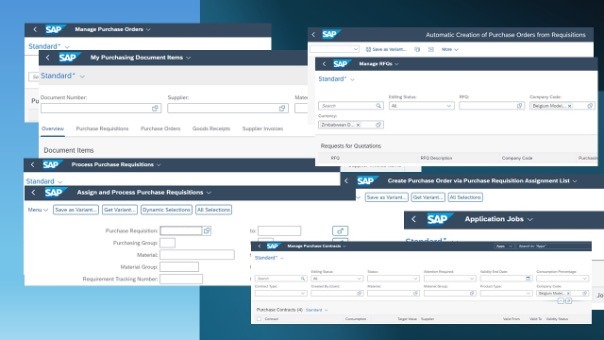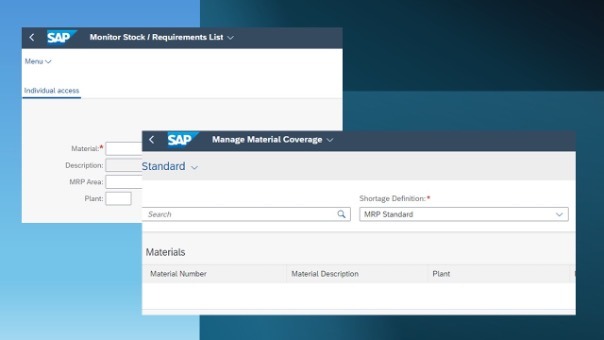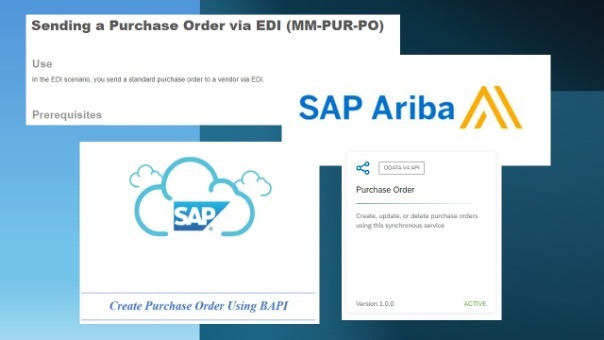I’ve encountered 16 distinct methods for creating a purchase order in SAP, and there are likely even more! A combination of old-school transaction codes with some of the newest Fiori apps available. Before you read along, you can think of the possibilities you know of, and compare them with the summary I’ve put together. Hopefully you’ll discover fresh possibilities to assist your customers in enhancing their daily purchasing tasks to a higher standard.
Without reference / from scratch

1. Create Purchase Order – Advanced
Starting off with the most obvious one. This app does exactly what the naming says, creating a purchase order to procure goods and services from vendors. Accessible through transaction code ME21N.
From a report / overview

2. Manage Purchase Orders
This Fiori app offers a user-friendly interface for efficiently managing the purchase order lifecycle, from creation and approval to tracking and analysis.
3. My Purchasing Document Items – Professional
This Fiori app is designed to provide users a centralised and intuitive interface for managing their purchasing activities, allowing them to efficiently track, monitor, and take action on relevant purchasing document items.
4. Manage Purchase Contracts
This app seamlessly integrates with other procurement processes within the SAP system, such as purchase orders. It’s possible within the app to create a purchase order, based on a purchase contract.
5. Assign and Process Purchase Requisitions
This app lets you search for specific purchase requisitions based on criteria such as requisition number, material, department or status. Also here, converting a purchase requisition into a purchase order is one of its functionalities. Accessible through transaction code ME57.
6. Process Purchase Requisitions (V2)
This app primarily focuses on the processing and approval of purchase requisitions once they have been assigned to the appropriate individuals or teams. A purchase order can be created from a requisition.
7. Create Purchase Order via Purchase Requisition assignment list
This functionality enables users to generate purchase orders directly from a list of assigned purchase requisitions.
8. Automatic Creation of Purchase Orders from Requisitions
This functionality streamlines the procurement process, reduces manual effort, and improves efficiency by automating the generation of purchase orders directly from approved purchase requisitions. Accessible through transaction code ME59.
9. Schedule Purchasing Jobs – Advanced
Organisations configure the SAP system to automate specific procurement tasks by defining job schedules, triggers, and parameters. This can be done using SAP’s job scheduling tools. One of the job types here is a scheduled job for creating purchase orders from approved requisitions.
10. Manage RFQs
Managing RFQs in SAP involves a structured and efficient process for soliciting, evaluating, and selecting vendor quotations, ultimately enabling organisations to make informed purchasing decisions and secure the best value for their procurement needs. After the rewarding of a quotation, the user can create a purchase order.
From material requirement

11. Monitor Stock / Requirements List
Based on the information displayed in in this app, users can take various actions to address material shortages or excess inventory. This may include creating or rescheduling purchase orders, adjusting production schedules, reallocating stock, or taking other corrective measures. Accessible through transaction code MD04.
12. Manage Material Coverage
The functionality generates procurement proposals based on coverage analysis and demand forecasts. These proposals may include recommendations for creating or rescheduling purchase orders, production orders, or stock transfers to maintain optimal inventory levels.
Through an interface

13. Purchase Orders API
SAP provides various APIs (Application Programming Interfaces) for interacting with its system. For creating a purchase order, you would typically use an API that allows for the creation and modification of purchase orders. Make sure to have a look at all the API’s available at api.sap.com.
14. Purchase Order Creation Through EDI
Creating purchase orders in SAP through Electronic Data Interchange (EDI) involves exchanging standardised electronic messages between SAP and its trading partners to automate the procurement process.
15. Create Purchase Order with SAP Ariba
SAP Ariba is often integrated with SAP ERP systems to ensure seamless processing of purchase orders and related transactions. Integration enables real-time synchronization of procurement data, including purchase orders, invoices, and supplier information, between Ariba and SAP ERP.
16. Create purchase Order Through BAPI
Creating purchase orders in SAP using BAPIs provides a flexible and programmable approach to automate procurement processes and integrate SAP with external systems. It enables organisations to streamline procurement operations, improve efficiency, and reduce manual effort in creating purchase orders.
Wrapping it up
As you can see, there are plenty of choices for creating a purchase order in SAP. It’s our job as consultants to determine which option best fits our customer’s needs and encourage them to use the one that delivers the most favourable results for their business. If you know any other ways to create a purchase order in SAP, feel free to share! Have questions? Shoot me a quick message, and let’s chat!
